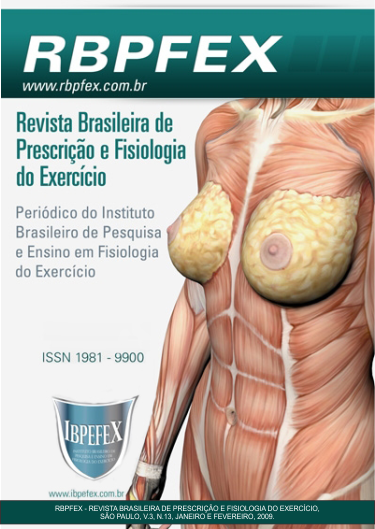Comparative analysis anthropometric enters the elite of cyclists of road Pernambucanos and the elite of Australian cyclist’s
Abstract
The anthropometric evaluation is used as an index related to performance in several sports. Therefore, the aim of this work was to compare anthropometrics measures and somatotypes of Elite cyclists off road from Pernambuco and literature data from Australian Elite Cyclists. Eighteen cyclists from Pernambuco (29.48 ± 15.3 yr, 172.4 ± 20.5 cm Ht, 69.2 ± 33.5 Kg Wt) were submitted to the anthropometrics and somatotypes measures, similar to Australians top ones. Parameters as the relationship between the seat height and the lower extremities length were not considered, because it was not in the purpose of this work. The analysis between the groups showed that there is no significant difference into the somatotypes, but we observed significant differences on age, height, upper and lower extremities length, circumferences and biacromial width.
References
- Barbosa, A.S.P.; Russo, A.K.; Piçarro, I.C.; Barros Neto, T.L.; Silva, A.C.; Tarasatchi, J. Características antropométricas de ciclistas, corredores de longa distância e não atletas e sua correlação com eficiência do trabalho na cicloergômetro e esteira rolante. Revista Brasileira de Ciência do Esporte. v. 8 (2 e 3), p. 166 – 170, 1987.
- Burke, E. R. Physiology of cycling In: Garret, W.E.; Kirkendall, D.T. (Eds.). Exercise and sport science. Philadelphia: Lippincott Williams & Wilkins, 2000, p. 759-770.
- Carnaval, P.E. Medidas e Avaliação em ciências do esporte. 3ª ed. Rio de Janeiro: Sprint, 1998. 173 p. Cap. 3: Avaliação Somatotipológica.
- Coyle, E. F.; Feltner, M. E.; Kautz, S. A.; Hamilton, M. T.; Montain, S. J.; Baylor, A.M.; Abraham, L.D.; Petrek, G.W. Physiological and Biomechanical factors associated with elite endurance cycling performance, Medicine Science and Sports Exercise. v. 23(1), p.93-107, 1991.
- Foley, J.P., Bird, S.R., White, J.A. Anthropometric comparison of cyclist from different events. British Journal of Sports Medicine. v. 23(1), p. 30-3, 1989.
- Going, S.; Davis, R. Composição Corporal. In: Roitman, J. L. (Ed.), Manual de pesquisa das diretrizes do ACMS para os Testes de Esforço e sua Prescrição. 4ª ed. Rio de Janeiro: Guanabara Koogan, 2002, p. 393-401.
- Gregor, R. J. Biomechanics of cycling In: Garret, W.E.; Kirkendall, D.T. (Eds.). Exercise and sport science. Philadelphia: Lippincott Williams & Wilkins, 2000, p. 515-538.
- Heyward, V.H.; Stolarczyk, L.M. Avaliação da Composição Corporal Aplicada. São Paulo: Manole, 2000. 243 p. Cap. 1:Fundamentos da Composição Corporal.
- McLean, B.D.; Parker, A.W. An anthropometric analysis of elite Australian track cyclist. Journal of Sports Sciences. v. 7, p. 247–255, 1989.
- Tritschler, K.A. Medida e Avaliação em Educação Física e Esportes de Barrow & McGee. São Paulo: Manole, 2003. 828 p. Cap. 8: Avaliando a composição corporal.
Authors who publish in this journal agree to the following terms:
- Authors retain the copyright and grant the journal the right of first publication, with work simultaneously licensed under the Creative Commons Attribution License BY-NC which allows the sharing of the work with acknowledgment of the authorship of the work and initial publication in this journal.
- Authors are authorized to enter into additional contracts separately for non-exclusive distribution of the version of the work published in this journal (eg, publishing in institutional repository or book chapter), with acknowledgment of authorship and initial publication in this journal.
- Authors are allowed and encouraged to post and distribute their work online (eg, in institutional repositories or on their personal page) at any point before or during the editorial process, as this can bring about productive change as well as increase impact and impact. citation of published work (See The Effect of Free Access).






